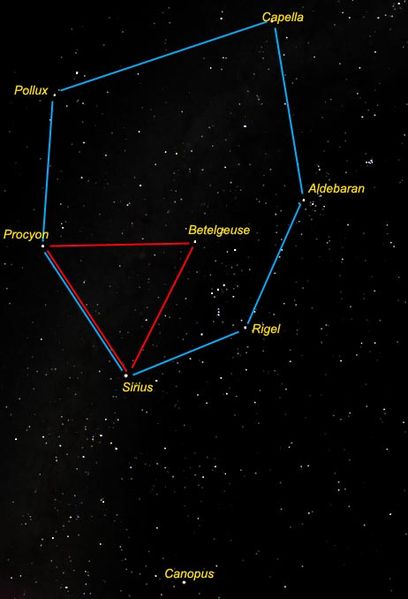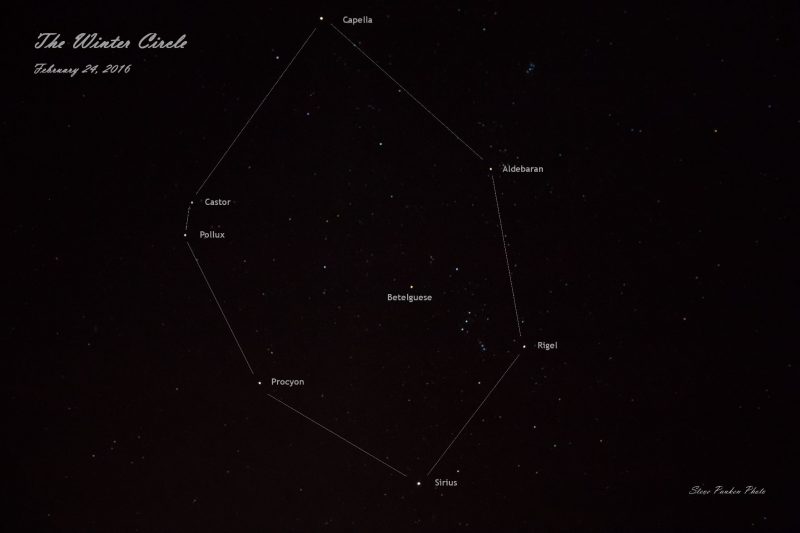
On February 4 and 5, 2020, you’ll find the waxing moon shining inside a large asterism that we in the Northern Hemisphere call the Winter Circle (or Winter Hexagon). It’s a very large star pattern made of brilliant stars. Around the world on this night, the moon shines inside the Circle. The pattern is eastward in early evening, highest in the sky around mid-evening and will have drifted into your western sky by after midnight. Note that our chart is set for Northern Hemisphere viewers. From the Southern Hemisphere, the same stars appear near the moon, but the Circle is upside-down with respect to our chart, with star Sirius near the top.
Try Stellarium Online for your precise view from your location.
The Winter Circle isn’t one of the 88 recognized constellations. It’s an asterism, a pattern of stars that’s fairly easy to recognize. Our sky chart can’t adequately convey the Winter Circle’s humongous size! It dwarfs the constellation Orion the Hunter, which is a rather large constellation, occupying the southwestern part of the Winter Circle pattern.

The Winter Circle in blue. It contains another asterism, or familiar star pattern – called the Winter Triangle – in red. These stars will be out in the evening sky for several months to come. Image via Wikimedia Commons.
Here’s how to locate the Winter Circle from mid-northern latitudes. At nightfall and early evening, look high overhead for the bright star Capella. This star marks the top (or more properly, the northern terminus) of the Winter Circle.
As Capella shines way overhead, the constellation Orion the Hunter is prowling in the southern sky. Draw a line downward through Orion’s Belt to find Sirius, the brightest star in the night sky. This star marks the bottom (the southern tip) of the Winter Circle, as seen from our Northern Hemisphere perspective
By the way, during these next few nights, the waxing gibbous moon shows you where the sun resides in front of the backdrop stars in June. So enjoy the Winter Circle. And contemplate the sun being in this part of the sky when summer returns to the Northern Hemisphere!

View at EarthSky Community Photos. | Steve Pauken captured the Winter Circle in 2016 and wrote: “After seeing an illustration in EarthSky, I went out the back door to look for it. It was directly overhead, so I put my camera on the tripod, aimed straight up, and captured the image after a few tweeks for focus.”
Bottom line: On the evenings of February 4 and 5, 2020, the waxing gibbous moon shines inside the huge pattern of stars known as the Winter Circle. Be sure to notice the different colors of these stars!
More on the Winter Circle: Brightest winter stars
Enjoying EarthSky so far? Sign up for our free daily newsletter today!
from EarthSky https://ift.tt/3b79dAl

On February 4 and 5, 2020, you’ll find the waxing moon shining inside a large asterism that we in the Northern Hemisphere call the Winter Circle (or Winter Hexagon). It’s a very large star pattern made of brilliant stars. Around the world on this night, the moon shines inside the Circle. The pattern is eastward in early evening, highest in the sky around mid-evening and will have drifted into your western sky by after midnight. Note that our chart is set for Northern Hemisphere viewers. From the Southern Hemisphere, the same stars appear near the moon, but the Circle is upside-down with respect to our chart, with star Sirius near the top.
Try Stellarium Online for your precise view from your location.
The Winter Circle isn’t one of the 88 recognized constellations. It’s an asterism, a pattern of stars that’s fairly easy to recognize. Our sky chart can’t adequately convey the Winter Circle’s humongous size! It dwarfs the constellation Orion the Hunter, which is a rather large constellation, occupying the southwestern part of the Winter Circle pattern.

The Winter Circle in blue. It contains another asterism, or familiar star pattern – called the Winter Triangle – in red. These stars will be out in the evening sky for several months to come. Image via Wikimedia Commons.
Here’s how to locate the Winter Circle from mid-northern latitudes. At nightfall and early evening, look high overhead for the bright star Capella. This star marks the top (or more properly, the northern terminus) of the Winter Circle.
As Capella shines way overhead, the constellation Orion the Hunter is prowling in the southern sky. Draw a line downward through Orion’s Belt to find Sirius, the brightest star in the night sky. This star marks the bottom (the southern tip) of the Winter Circle, as seen from our Northern Hemisphere perspective
By the way, during these next few nights, the waxing gibbous moon shows you where the sun resides in front of the backdrop stars in June. So enjoy the Winter Circle. And contemplate the sun being in this part of the sky when summer returns to the Northern Hemisphere!

View at EarthSky Community Photos. | Steve Pauken captured the Winter Circle in 2016 and wrote: “After seeing an illustration in EarthSky, I went out the back door to look for it. It was directly overhead, so I put my camera on the tripod, aimed straight up, and captured the image after a few tweeks for focus.”
Bottom line: On the evenings of February 4 and 5, 2020, the waxing gibbous moon shines inside the huge pattern of stars known as the Winter Circle. Be sure to notice the different colors of these stars!
More on the Winter Circle: Brightest winter stars
Enjoying EarthSky so far? Sign up for our free daily newsletter today!
from EarthSky https://ift.tt/3b79dAl

Aucun commentaire:
Enregistrer un commentaire